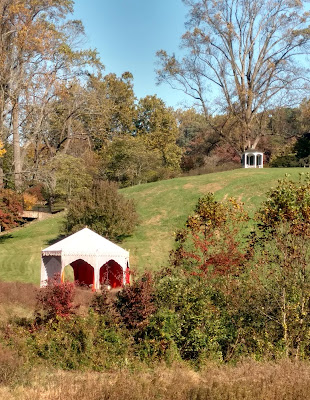In the end, we each need only as many chairs as we have friends.
| Folly, by Carol L. Douglas. 24X18 |
Plein Air Brandywine Valley is unusual in that the sales part is three days long. Usually, we paint at these events and then there’s a short auction or sale. Boom, we’re done and go home. This long sale period harks back to my days at art fairs, where we each had a tent and stood around wishing we’d brought our bocce kit.
But at least we don’t have to set our displays up. Tonight at seven we’ll appear at Winterthur, faces washed and the grime cleaned out from under our fingernails, to meet the public.
 |
| In case you think I was making things up, here is the Moorish tent folly and summerhouse from my painting. |
Winterthur bills itself as “an American country estate.” It’s a classic, aping the great landed estates of Europe. Primarily distinguished by its size, it has 175 rooms and 1600 acres (in its current, downsized, form). It has some fantastic specimen trees, all grown to luxurious maturity.
Whipping along its lanes in a chauffeured golf cart, I am reminded of an aphorism spuriously credited to one of the Barons Rothschild: “No garden, no matter how small, should have less than a hundred-acre woodlot.”
| Home Farm, by Carol L. Douglas. This may not be the real home farm to this estate, but it’s one of many that du Pont collected and preserved to create Winterthur. |
Winterthur was the life’s work of Henry Francis Du Pont. His father—also a Henry—graduated first in his class from West Point and served in the Senate. His grandfather—another Henry—was head of the du Pont conglomerate during the Civil War. A steadfast supporter of Lincoln, he held pro-slavery Delaware in the Union and refused to sell gunpowder to the south. His great-grandfather was, of course, the legendary E. I. du Pont.
That family genius seemed to bypass young Henry Francis. He was a horticulturist and collector of early American furniture and decorative arts. “I know that I am stupid,” he wrote his father while at school at Groton. He frequently described himself as “a farmer.” His father encouraged his interest in the breeding of Frisian cattle, thinking it more useful than buying a yacht.
| I framed work on Bruce McMillan‘s car, since the Prius hood isn’t designed to set things on and the interior was too messy. |
In the absence of commercial zeal, young Henry became an expert on American furnishings and interiors, gradually turning his home into a museum of American art and antiques. Many rooms were rescued from historic structures. The collection spans two centuries, from 1640 to 1840, and also includes a preposterously large library on the subject.
| Painting along the Brandywine. Photo courtesy of Bruce McMillan. |
I’m always melancholy when visiting these historic homes. They’re where unimaginable wealth meets limited imagination. I’m glad Henry Francis du Pont preserved this collection of farms (especially considering the growth in Delaware in recent decades). I’m happy, too, that he salvaged these historic interiors for future generations. But, in the end, we each need only as many chairs as we have friends.


